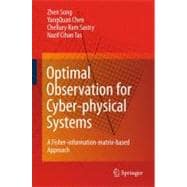
| Abbreviations and Notation | p. xv |
| Introduction | p. 1 |
| Motivation for the Book | p. 1 |
| Challenges of Observation for Cyber-physical Systems | p. 1 |
| Lessons Learned from Experience | p. 3 |
| Summary of Contributions | p. 5 |
| Organization | p. 5 |
| A Short Overview of CPSs | p. 6 |
| The Concepts | p. 6 |
| What Is a Sensor Network? | p. 7 |
| Introduction to WSNs | p. 7 |
| Applications of WSNs | p. 9 |
| Research, on WSNs from Different Aspects | p. 11 |
| Motivation and Application Scenarios | p. 14 |
| Motivation and Scenarios for MAS-net | p. 14 |
| Scenarios for Sensor Selection | p. 18 |
| Scenario for WSN-Based Localization | p. 20 |
| Mathematical Background | p. 21 |
| Mobile Sensor Trajectory Optimization | p. 27 |
| Motivation and the Application Scenario | p. 27 |
| System Identification for DPSs | p. 27 |
| Problem Formulation | p. 30 |
| The Dynamic Model of Differentially Driven Robots | p. 30 |
| The Model of the Diffusion Process | p. 32 |
| The Objective Function for Sensor Motion Scheduling | p. 33 |
| Problem Reformulation in the Optimal Control Framework | p. 35 |
| Finding a Numerical Solution for the Problem | p. 36 |
| A Brief Introduction to RIOTS | p. 36 |
| Using MATLAB“ PDE Toolbox Together with RIOTS | p. 37 |
| Illustrative Simulations | p. 38 |
| Differentially Driven and Omnidirectionally Driven | p. 38 |
| Comparison of Robots with Different Capabilities | p. 41 |
| On the Effect of the Initial Orientation | p. 41 |
| Chapter Summary | p. 43 |
| Sensor Selection Methods for Cyber-physical Systems | p. 45 |
| The Motivation and the Problem | p. 45 |
| Just-Enough Sensor Selection and the Solution | p. 46 |
| Literature Review | p. 46 |
| Overview of Our Strategy | p. 51 |
| The Heuristic Sensor Selection Method | p. 53 |
| Formulation of Heuristic Sensor Selection | p. 53 |
| Pseudocode of the hCOSS Algorithm | p. 61 |
| Analysis of the hCOSS Algorithm | p. 63 |
| The Elimination-Based Sensor Selection Method | p. 75 |
| Motivation | p. 75 |
| An Intuitive Interpretation | p. 76 |
| Problem Formulation | p. 76 |
| Convex Elimination Algorithm | p. 78 |
| Analysts of Convex Elimination Algorithm | p. 79 |
| Examples | p. 84 |
| Pseudocode of the eCOSS Algorithm | p. 90 |
| Simulations | p. 92 |
| Overview | p. 92 |
| Case 1 | p. 96 |
| Case 2 | p. 96 |
| Case 3 | p. 98 |
| Case 4 | p. 99 |
| Case 5 | p. 99 |
| Hardware Experiments | p. 100 |
| Discussion | p. 114 |
| Remarks on the Speed and Memory Requirements | p. 114 |
| Comments on Non-Gaussian Noise | p. 115 |
| Relationships with Geometric Approaches | p. 116 |
| Entropy-Based Method | p. 121 |
| Discussion of Correlations of Sensor Data | p. 122 |
| Comments on Networking | p. 125 |
| Chapter Summary | p. 127 |
| Design of Localization Systems for Wireless Sensor Networks | p. 129 |
| The Motivation and the Research Problem | p. 129 |
| Localization Hardware | p. 129 |
| Received Signal Strength Indicator | p. 129 |
| Angle of Arrival | p. 130 |
| Acoustic TOF | p. 130 |
| RF TOF Measurement | p. 130 |
| The Proposed Phase-Based Localization Method | p. 132 |
| Review of TDOA Localization Algorithms | p. 132 |
| Problem Formulation | p. 334 |
| Beacon Placement Optimization | p. 140 |
| Application Scenarios | p. 140 |
| Problem Formulation | p. 141 |
| Solution and Simulation | p. 143 |
| Chapter Summary | p. 150 |
| Conclusions and Future Work | p. 155 |
| Conclusions | p. 153 |
| Future Work | p. 152 |
| Implementations | p. 153 |
| Simulation of Trajectory Optimization | p. 153 |
| Sensor Selection Demonstration System | p. 157 |
| Reference | p. 159 |
| Index | p. 169 |
| Table of Contents provided by Ingram. All Rights Reserved. |
The New copy of this book will include any supplemental materials advertised. Please check the title of the book to determine if it should include any access cards, study guides, lab manuals, CDs, etc.
The Used, Rental and eBook copies of this book are not guaranteed to include any supplemental materials. Typically, only the book itself is included. This is true even if the title states it includes any access cards, study guides, lab manuals, CDs, etc.